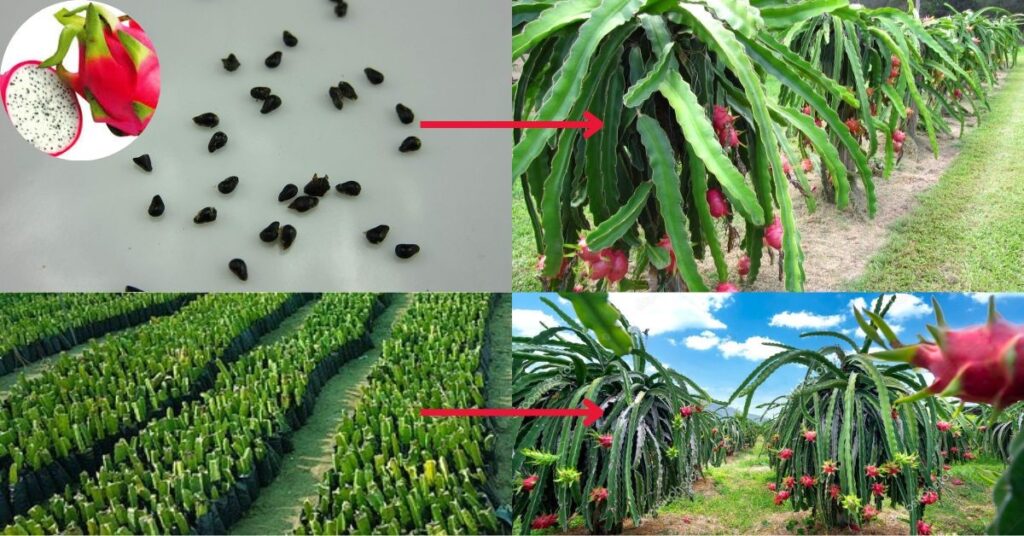“Why is dragon fruit uncommon?” In the realm of exotic fruits, one particular specimen stands out for its striking appearance and intriguing name: the dragon fruit. With its vibrant pink or yellow skin and speckled flesh dotted with tiny black seeds, the dragon fruit is indeed a sight to behold. Yet, despite its visual allure and purported health benefits, the dragon fruit is uncommon in many parts of the world. What are the reasons behind this enigmatic fruit’s relatively low popularity?
Dragon fruit uncommon

Cultivation Challenges:
One of the primary reasons for the dragon fruit’s limited prevalence lies in the intricacies of its cultivation. Unlike more ubiquitous fruits like apples or oranges, which can thrive in a variety of climates and soil conditions, dragon fruit requires specific environmental parameters to flourish. This finicky fruit thrives in tropical and subtropical regions, where temperatures remain consistently warm and humidity levels are moderate. Moreover, dragon fruit plants are sensitive to frost, making them unsuitable for cultivation in regions prone to cold snaps. As a result, the availability of fresh dragon fruit is largely constrained to areas with the requisite climate conditions, limiting its reach to global markets.
Slow Growth and Limited Yields:
Another factor contributing to the dragon fruit’s uncommon status is its relatively slow growth rate and modest yields. Unlike some fruits that can bear multiple harvests throughout the year, dragon fruit typically produces fruit only once or twice annually. Additionally, dragon fruit plants take several years to reach maturity before they can begin fruiting, further extending the timeline for growers to yield a profitable crop. With limited yields per plant and extended growth periods, the cultivation of dragon fruit may not be as economically viable for farmers compared to other crops with quicker turnover rates.

Transportation Challenges:
Even if dragon fruit is successfully cultivated in regions conducive to its growth, another hurdle arises when it comes to transportation. The delicate nature of dragon fruit, coupled with its short shelf life, poses logistical challenges for distributing the fruit to distant markets. Unlike heartier fruits like apples or bananas, which can withstand rough handling and extended transit times, dragon fruit requires careful packaging and expedited shipping to preserve its freshness. As a result, the cost of transporting dragon fruit over long distances can be prohibitive, further limiting its availability in areas far from its cultivation sites.
High Cost and Limited Demand:
The cost of dragon fruit can also contribute to its uncommon status. Due to the aforementioned cultivation challenges, as well as the expenses associated with transportation and handling, dragon fruit tends to command a higher price point compared to more mainstream fruits. This higher cost may deter consumers, particularly those on tighter budgets, from purchasing dragon fruit regularly. Additionally, in regions where dragon fruit is less well-known or where culinary traditions do not incorporate it prominently, there may be limited demand for the fruit, further constraining its popularity and market presence.
Varietal Diversity:
Although dragon fruit may seem like a singular entity, there are actually several distinct varieties of the fruit, each with its own unique characteristics. The two main types of dragon fruit are the Hylocereus undatus, characterised by its white flesh and pink skin, and the Hylocereus megalanthus, which features yellow skin and white flesh. Additionally, there are hybrids and cultivars that exhibit variations in colour, flavour, and texture. While this diversity adds to the allure of dragon fruit for enthusiasts and connoisseurs, it can also contribute to confusion among consumers and retailers alike. Without a clear understanding of the differences between various dragon fruit varieties, consumers may be hesitant to try unfamiliar types, further limiting the fruit’s popularity and consumption.
Limited Culinary Applications:
Despite its visually striking appearance, dragon fruit’s flavour profile is often described as mild and subtly sweet, with a texture reminiscent of kiwi or pear. While some may find its taste appealing, others may find it underwhelming compared to more boldly flavoured fruits. Moreover, dragon fruit’s relatively neutral flavour can make it challenging to incorporate into culinary creations, particularly in dishes where it must compete with other ingredients for attention. As a result, chefs and home cooks may be less inclined to experiment with dragon fruit in their recipes, further limiting its presence on menus and in kitchens worldwide.
Cultural Significance:
In regions where dragon fruit is native or has a long-standing cultural presence, such as Southeast Asia and Central America, it enjoys a more prominent position in local cuisines and traditions. In these areas, dragon fruit may be revered for its auspicious symbolism or prized for its purported health benefits. However, in other parts of the world where dragon fruit is considered a novelty or exotic import, its cultural significance may be less pronounced. Without deep-rooted cultural associations or culinary traditions to bolster its popularity, dragon fruit may struggle to gain traction in new markets.

Health Benefits and Superfood Status:
Despite its relatively low popularity, dragon fruit has garnered attention in recent years for its potential health benefits and status as a “superfood.” Rich in antioxidants, vitamins, and fibre, dragon fruit is touted for its ability to support immune function, aid in digestion, and promote overall well-being. Additionally, the fruit’s vibrant pigmentation is attributed to the presence of beneficial compounds such as betalains, which have anti-inflammatory properties. While these health claims may pique the interest of health-conscious consumers, they may not be sufficient to drive widespread adoption of dragon fruit, particularly if other fruits with similar nutritional profiles are more readily available.
In conclusion
The reasons behind dragon fruit’s uncommon status are multifaceted, stemming from cultivation challenges, transportation constraints, economic factors, and culinary considerations. While this exotic fruit may captivate with its striking appearance and purported health benefits, its limited availability and higher cost can pose barriers to widespread consumption. Nevertheless, for those willing to seek out this elusive fruit, the experience of indulging in its subtle sweetness and embracing its cultural significance can be a rewarding endeavour.
